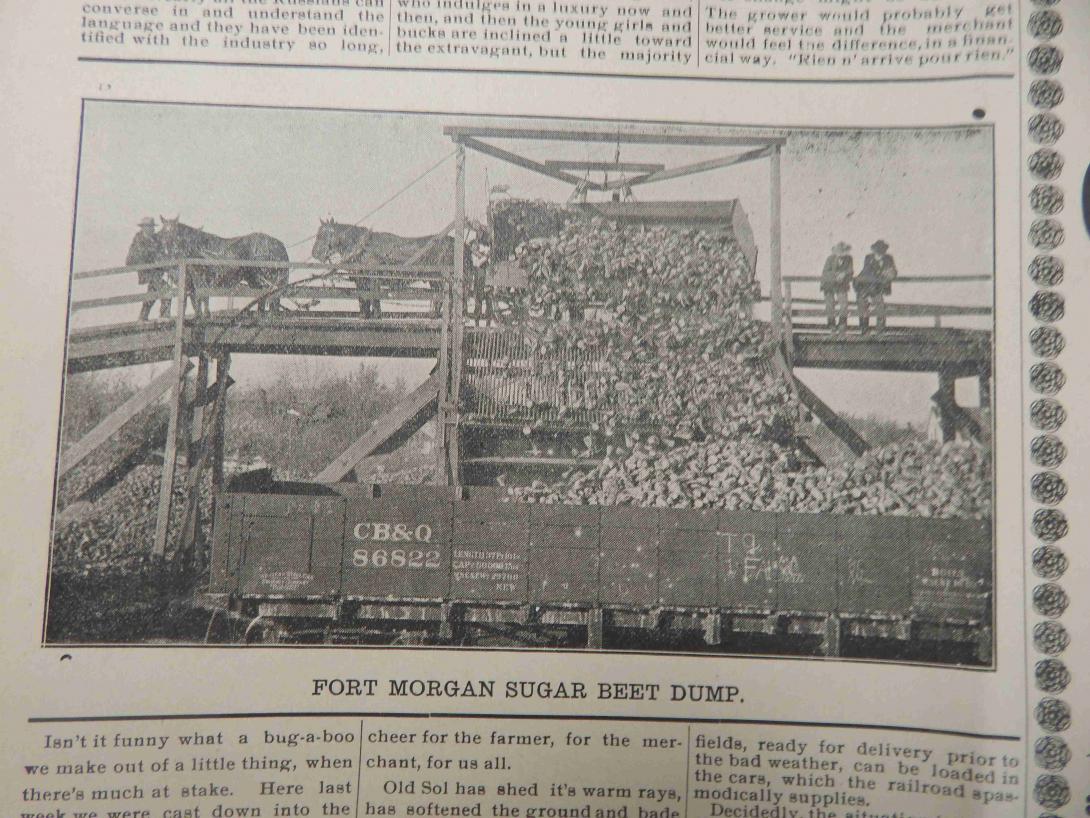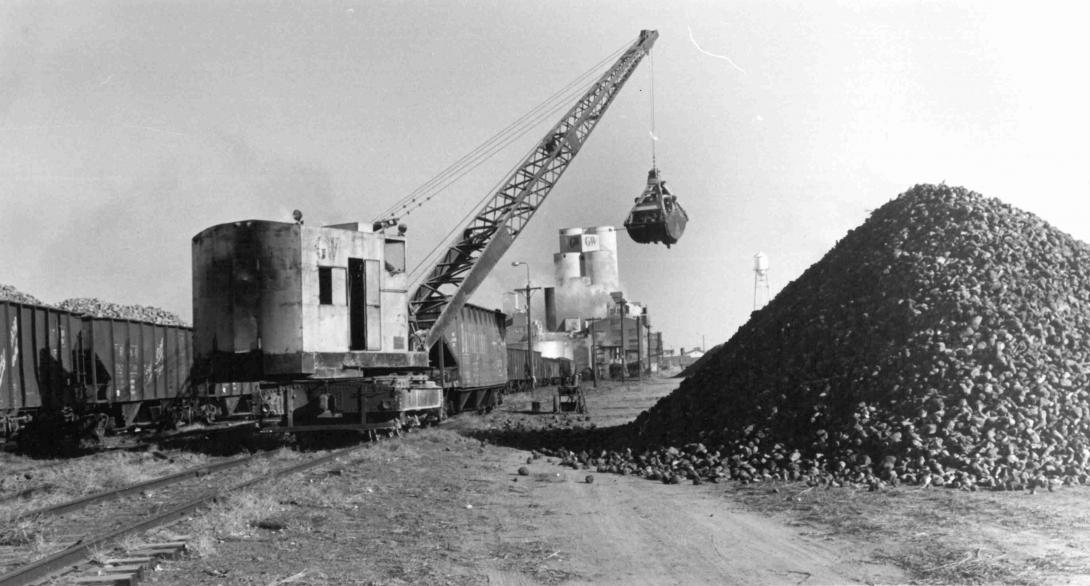Great Western Sugar Company
Full Article
The Great Western Sugar Company was co-founded by Charles Boettcher in 1900 after he observed the hardy, profitable sugar beet crop while vacationing in Europe. In Colorado, the sugar beet industry he helped launch proved a boon to the state and local communities for nearly eighty years. After experiencing financial hardship in the 1970s and 1980s, Great Western was sold to a cooperative in the city of Fort Morgan, where beet processing remains an important industry.
Over the last 120 years, the sugar beet crop has brought millions of dollars to local economies in Berthoud, Brush, Fort Collins, Greeley, Longmont, Loveland, and other places along the northern Front Range. Supported by irrigation, beet cultivation was lucrative for farmers, especially because Great Western brought in an inexpensive immigrant workforce. Beet farms and Great Western factories influenced the immigration patterns of northern Colorado, as they employed German, Asian, and Mexican immigrants.
Early Years
Farmers in Colorado cultivated sugar beets before Great Western. In 1899 the Colorado Sugar Manufacturing Company built the state’s first beet-processing factory in Grand Junction. That plant went through a series of sales before it ceased full-time operations in 1929.
On the Front Range, where existing irrigation networks already supported farming communities, Charles Boettcher applied his vision and resources to exploit the crop’s full potential. Boettcher was already known as a savvy businessman and capitalist who first found wealth as a hardware merchant in the mining towns of Colorado. He later tried his hand at ranching and then opened the Great Western Packing Company in Denver to slaughter his cows.
In 1901 Boettcher and partners John Campion, William Byrd Page, J.R. McKinnie, and Boettcher’s son Claude opened a sugar beet factory in Loveland. One of the keys to the success of this factory was the spur of the Colorado & Southern Railroad that transported the refined sugar to Denver. Boettcher and his investors soon capitalized on this themselves, and that same year the Great Western Railroad was established to connect beet facilities in various stages of development in Nebraska, Colorado, Wyoming, and Montana. Boettcher also founded the Portland Cement Company so he would not have to import large amounts of foreign-made concrete to build his sugar beet factories.
Consolidation
Excitement over the potential profits from sugar beet refineries created a boom, and by 1905 independent factories opened in Greeley, Eaton, Fort Collins, Windsor and Longmont. Shortly afterward, Henry O. Havemeyer’s American Sugar Refining Company acquired these factories. Havemeyer then brokered a deal with Boettcher and his new partner, Chester S. Morey, that combined American Sugar with Boettcher’s company under the name Great Western Sugar. This consolidated a large part of the refining industry, providing farmers with a dependable market and assuring stable prices for the sugar beets they produced each year. Great Western opened a factory in Brush in 1906 and a Brighton factory in 1917. The expansion of Great Western’s holdings made sugar beet farming and refining two of the most profitable industries in Colorado.
Fort Morgan Factory
Of all the factories Great Western established in its early years, the Fort Morgan factory has proven the most resilient, enduring to the present despite some struggles in the late twentieth century. It provides a useful case study for examining the history of Great Western and the company’s influence on northeast Colorado.
Fort Morgan founder Abner S. Baker and town promoter George Warner are credited with convincing Great Western to build its Fort Morgan factory in 1906. Existing irrigation networks along the South Platte River meant that the town could support commercial beet production. The Jackson Lake reservoir, which at the time was the largest reservoir in northeast Colorado, was specifically built to attract a Great Western Sugar factory. Ritter-Conley Manufacturing began construction of the factory in 1906. Even before the facility opened, Great Western reportedly distributed $400,000 in wages to workers and to farmers who were growing beets. On December 26, 1906, the factory processed its first load of sugar beets, and it was fully operational by 1907.
The factory greatly influenced the growth of the town. It is estimated that the first beet crop processed at the new factory grossed over $1 million, an unimaginable sum in 1906. The Fort Morgan Times boasted that farmers could make between thirty and fifty dollars per acre (between $700 and $1,000 today) and noted that yields per acre were estimated at eighteen to twenty tons. Within a few short years, the town of Fort Morgan had tripled in size and land had tripled in value. Between 1906 and 1908, some 200 new houses were built in Fort Morgan.
Immigrants
Great Western first brought in German-Russian immigrants to work the fields and factory. Approximately 1,000 arrived in the Fort Morgan area from Nebraska to work the fields in the spring, and they returned after the harvest in the fall. This immigrant population lived in modest housing close to the factory or in small shacks on the farms they worked. Within a few years, many of these workers saved enough to purchase their own houses, raise livestock, and plant large gardens to help feed their families. Many current residents of Morgan County trace their roots to this population. They created a tight-knit community that emphasized a strong work ethic and self-sufficiency.
During the 1920s and 1930s, Great Western also brought in Mexican workers, known as betabeleros and sent agents as far south as El Paso to recruit them. The company provided low-interest loans to Mexican workers to purchase land near the factory, where they created a thriving Latino community known as the “Spanish colony.” The factory provided building materials and leased the lots at affordable rates that could be paid off in five years. After the Great Depression and World War II, this population declined. The factory also used contract Mexican laborers, known as braceros, until the 1950s, when a push to eliminate foreign laborers resulted in many of these workers being deported to Mexico.
Fort Morgan’s Latino community experienced a revival in the 1960s when a local group, the Association for Community Cooperation in Our Neighborhood (ACCIÓN), formed to improve living conditions in the colony. Most notably, the organization worked with the city to add water, sewer, and power lines. In the 1980s, the Mexican American community was estimated to make up approximately one-quarter of Fort Morgan’s population. Like the descendants of German-Russian workers, many families in today’s Fort Morgan trace their roots to the Mexican and Mexican American laborers of the 1920s and 1930s.
Great Depression and World War II
The mid-1920s found the Great Western factory flourishing and beet acreage increasing along the northern Front Range, especially around Fort Morgan. In 1923 the Fort Morgan factory spent $80,000 on expansions such as building a large silo to store beets. During the late 1920s and early 1930s, the factory also experimented with different types of fertilizer to improve yields. The years of the Great Depression were difficult, and weather caused problems for the beet harvest. A snowstorm froze the 1929 beet crop in the ground, crippling many farmers’ returns. Despite these setbacks, Great Western continued to expand and became one of the largest producers of beet sugar in the world.
During World War II, soldiers leaving home created a labor shortage for farmers in Morgan County. To meet this need, prisoners of war from Germany and Italy worked in the beet fields.
Midcentury
After the war, Colorado’s population increase meant that more land was needed for housing instead of farming, which changed the economic environment for sugar beet cultivation. Great Western closed its factories in Fort Collins, Brush, and Fort Lupton. The Fort Morgan factory flourished, however, and more than a decade later, the factory payroll was estimated to be more than half a million dollars. In 1948 Charles Boettcher died, and Great Western Sugar lost its most prominent leader, but the company continued to earn record profits.
In 1966 Great Western paid farmers a total of $6 million for their crops. However, lack of innovation in some areas, such as continuing to transport beets by rail instead of truck, caused problems for the company. By 1967 Great Western Sugar and its holdings were sold to Billy White, who eventually sold the company to the Hunts Brothers Organization. Unfortunately, the timing of this sale coincided with the rising popularity of artificial sweeteners during the 1970s. This change in the market destabilized the Fort Morgan factory and its parent company, now known as Great Western United. Several times, farmers tried to form growers associations (or cooperatives) to purchase the company and continue operations, but the Hunts Brothers thwarted this until the company teetered on the edge of bankruptcy and was again sold in 1984.
Corporation vs. Co-op
Things did not get any easier for sugar beet growers in the 1980s, as a surplus of refined sugar—from beets as well as sugarcane—drove down prices. The Fort Morgan factory closed for a short time, along with the factory in Sterling. The Fort Morgan factory later reopened, but the Sterling factory was converted to a storage facility.
In 1984 the company, which at the time operated seven factories and five warehouses, was sold to the Mountain States Beet Growers Association, a co-op with 2,200 members in Colorado and Kansas. Growers’ associations like this one emphasize the involvement of the farmer in all aspects of production, a philosophy known as “farm to table.” The Western Sugar Company purchased the cooperative two years later, began hiring, and eventually reopened the Fort Morgan factory. The result was a turnaround year for beets; the 1986 harvest totaled more than $9 million.
Still, the first cooperative gave sugar beet farmers a taste of controlling their own destiny, and soon they reorganized. In the early 2000s, five independent growers associations merged to form the Rocky Mountain Sugar Growers Cooperative. They bought Western Sugar from then-owners Tate and Lyle. In 2002 this co-op merged with Western Sugar as part of a deal worth $85 million. In time a new co-op emerged, the grower-owned Western Sugar Cooperative, which comprises more than 1,000 sugar beet growers in Colorado, Montana, Nebraska, and Wyoming. The group currently operates the Fort Morgan factory as well as storage facilities in Rocky Ford, Longmont, and Sterling.
The Fort Morgan facility is still in operation today as the state’s only functioning beet factory. It has closed only three times during its history—twice due to flooding and once due to an economic downturn. In 2018 Western Sugar Cooperative estimated that the facility would process more than 1 million tons of sugar beets. It employs approximately 90 seasonal workers in addition to a year-round staff of 115. The most enduring legacy of Charles Boettcher’s titanic twentieth-century corporation, the factory is also the longest-operating sugar-processing facility in Colorado and one of only a handful still operating in the region.




















